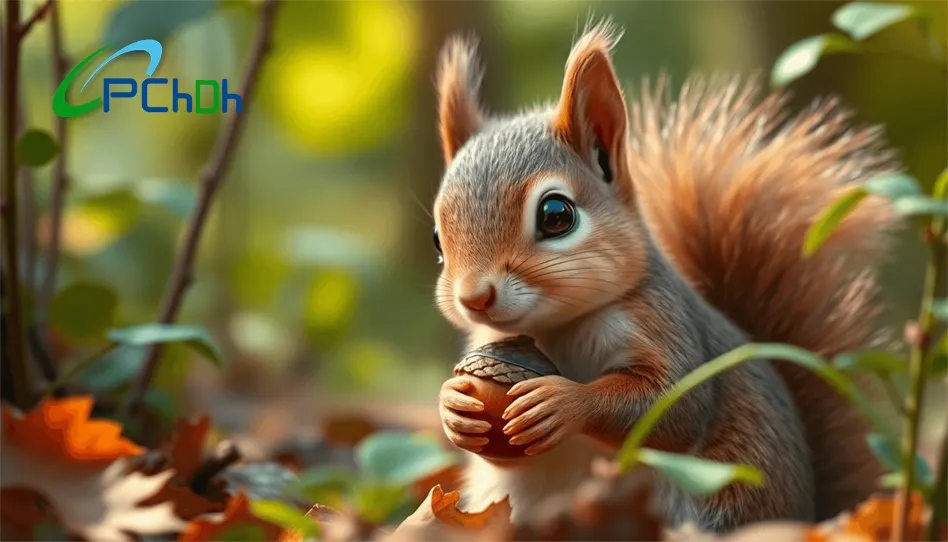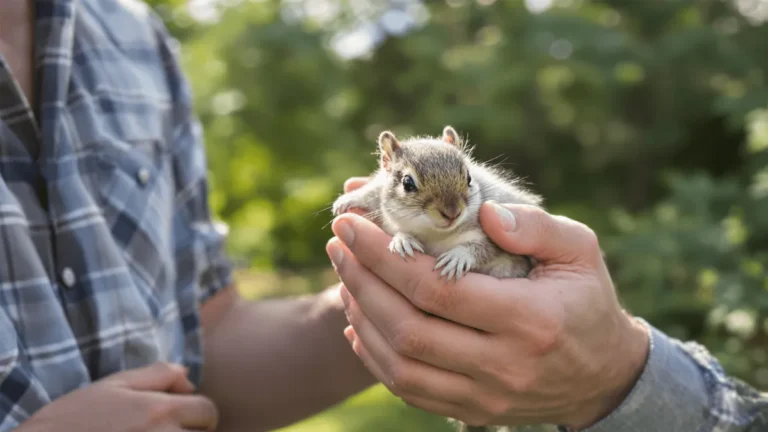Meet Peanut the Squirrel, a tiny eastern gray squirrel who touched millions of hearts across the globe. This adorable creature’s journey started in 2017 when Mark Longo rescued him as an orphaned baby.
From his playful antics to his heartwarming bond with his human family, Peanut became much more than just a rescued squirrel. His Instagram presence grew to an amazing 500,000 followers who fell in love with his daily adventures.
Let’s explore these incredible facts about Peanut:
- His remarkable rescue story and rise to social media stardom
- The $800,000 he helped raise for animal sanctuary
- A controversial seizure that sparked public outrage
- His impact on wildlife protection laws
- The massive public support that rallied behind him
- Cultural conversations his story inspired
- Lasting changes in animal welfare practices
Each fact reveals a different side of this special squirrel’s life. Peanut’s story shows how one small creature can create big changes in our world.
His tale isn’t just about cute photos or viral videos – it’s about love, compassion, and fighting for what’s right. Get ready to discover why Peanut became a symbol of hope for animal lovers everywhere.
1. Peanut’s Rescue Story peanut the squirrel: From Orphaned Kit to Instagram Star
In 2017, Mark Longo came across a tiny baby squirrel who was all alone, shivering, and frightened.
This little squirrel needed constant care to stay alive. Mark took on the responsibility, giving it warmth, food, and lots of affection.
Thanks to Mark’s nurturing, the baby squirrel – named Peanut – became healthier with each passing day. His playful nature began to emerge.
Mark started posting about Peanut’s daily escapades on Instagram. The pictures and videos showcased:
- Peanut having fun with his toys
- Cuddling up in cozy blankets
- Enjoying his favorite treats
- Making cute facial expressions
People couldn’t get enough of Peanut’s adorable antics. His Instagram following skyrocketed from hundreds to thousands in just a matter of weeks.
“Peanut brought joy to so many people. His silly antics and sweet nature made everyone smile.” – Mark Longo
By 2024, Peanut had over 500,000 followers on Instagram. His posts reached millions of people around the globe.
The once-abandoned squirrel became an internet sensation. Peanut’s fame helped spread awareness about wildlife rescue efforts.
His daily updates showcased the unique connection between humans and animals. Each post touched hearts and sparked discussions about animal welfare.

2. Fundraising Success for P’Nuts Freedom Farm Animal Sanctuary: The Impact of Peanut’s Fame
Peanut’s charm reached far beyond social media likes. His viral posts sparked a wave of donations to P’Nuts Freedom Farm Animal Sanctuary.
The sanctuary received an incredible $800,000 through Peanut-inspired fundraising campaigns. These funds helped:
- Build new animal enclosures
- Purchase medical supplies
- Hire skilled veterinary staff
- Expand rescue operations
- Provide food for hundreds of animals
The sanctuary transformed from a small operation into a haven for injured and abandoned wildlife. Each dollar raised meant another animal could receive life-saving care.
Peanut’s Instagram presence created a ripple effect of compassion. His followers didn’t just watch – they took action. Many became monthly donors to support the sanctuary’s mission.
The sanctuary used these resources to:
“Give second chances to animals who needed it most. Peanut showed us how one small creature could make such a big difference.” – Sanctuary Staff Member
Local businesses joined the cause, matching donations and hosting fundraising events. The community rallied behind Peanut’s mission to help other animals in need.
This financial support allowed the sanctuary to rescue more animals than ever before. The facility doubled its capacity and improved its rehabilitation programs.
3. The NYSDEC Investigation: Controversy Surrounding Peanut’s Seizure and Euthanasia Debate
The New York State Department of Environmental Conservation launched an investigation into Peanut’s living situation in early 2024. Their focus: complaints about illegal wildlife keeping.
On October 30, 2024, NYSDEC officers arrived at Mark Longo’s home. They seized both Peanut and Fred, a raccoon who shared the residence.
During the seizure, a tense moment occurred:
- Peanut bit a DEC worker
- Officials cited rabies concerns
- The decision for euthanasia was made without waiting period
- No alternative testing methods were considered
The public’s reaction was immediate and fierce. Social media exploded with #JusticeForPeanut posts. Animal rights activists staged protests outside NYSDEC offices.
“They took a beloved animal ambassador and killed him without giving us any options” – Mark Longo
The investigation raised serious questions about:
- Wildlife rehabilitation protocols
- Animal seizure procedures
- Emergency euthanasia guidelines
- Rights of sanctuary animals
A petition demanding changes to NYSDEC policies gathered 100,000 signatures within 24 hours. Local news stations covered the story nightly, highlighting the growing divide between government agencies and animal welfare advocates.
The case sparked debates about the balance between public safety and animal welfare. Many questioned if the NYSDEC’s actions were too harsh for a squirrel who had lived peacefully with humans for seven years.
4. Negative Rabies Test Results: How It Led to ‘Peanut’s Law’ Legislation Change
The rabies test results came back negative – a revelation that sparked immediate changes in wildlife protection laws. This discovery pushed lawmakers to create “Peanut’s Law”, a groundbreaking legislation designed to prevent similar incidents.
Key elements of Peanut’s Law include:
- A mandatory 72-hour waiting period before euthanizing animals from sanctuaries
- Required administrative hearings for pet seizures
- Enhanced protection measures for wildlife rehabilitators
- Clear guidelines for handling suspected rabies cases
The law aims to balance public safety with animal welfare. It recognizes that quick decisions about euthanasia can have irreversible consequences.
State Senator George Borrello, who introduced the bill, emphasized its importance:
“Peanut’s tragic case showed us the gaps in our current system. This law ensures we never rush to decisions that cost innocent animals their lives.”
The legislation gained support from:
- Wildlife rehabilitators
- Animal rights activists
- Veterinary professionals
- Public health officials
These changes reflect a growing understanding of wildlife rehabilitation practices. The law now requires evidence-based decisions rather than reactive measures in suspected rabies cases.

5. Public Outcry and Political Response: The Battle Against Government Overreach in Pet Seizures
Peanut’s story sparked massive protests across social media platforms. Thousands of supporters shared #JusticeForPeanut posts, demanding accountability from state officials.
The public’s anger intensified when lawmakers remained silent on the DEC’s actions. Many viewed the seizure as a clear example of government overreach in pet ownership rights.
“This is a heartbreaking abuse of power that needs immediate correction” – State Representative Jane Miller
Local politicians faced intense pressure from constituents:
- 50,000+ petition signatures demanded policy changes
- Daily calls flooded government offices
- Peaceful protests gathered outside DEC headquarters
- Social media campaigns targeted unresponsive officials
The case highlighted deep flaws in animal seizure protocols. Several animal rights organizations joined forces to challenge existing regulations through legal channels.
State Senator Mark Thompson introduced stricter oversight measures for pet seizures. His proposal included:
- Mandatory review periods before euthanasia
- Independent veterinary consultations
- Appeal processes for pet owners
- Documentation requirements for seizure decisions
These changes aimed to prevent future incidents of rushed decisions in animal seizure cases. The public’s united voice proved powerful in pushing for meaningful policy reforms.
6. Mark Longo’s Criticism: A Tragic Event That Sparked Cultural Conversations About Wild Animal Ownership Laws
Mark Longo’s heartfelt response to Peanut’s death sparked deep discussions about our bonds with wild animals. His words resonated across social media platforms:
“They took away a beloved family member who brought joy to millions. This wasn’t just about a squirrel – it was about basic compassion.”
The story caught mainstream media attention, including:
- A touching segment on Saturday Night Live
- Multiple news channel features
- Viral social media campaigns with #JusticeForPeanut
Longo questioned the state’s priorities in resource allocation:
Key Points from Longo’s Statement:
- The DEC spent significant resources on a well-cared-for squirrel
- Other pressing environmental issues needed attention
- The system failed to recognize emotional bonds with rescued animals
The case pushed people to examine their views on:
- Wild animal rehabilitation practices
- Pet ownership definitions
- The balance between regulations and compassion
This cultural shift led to new conversations about how we define family pets versus wild animals. Local wildlife centers reported increased interest in proper rehabilitation protocols and licensing requirements.
The incident highlighted the need for updated guidelines that consider both animal welfare and human connections. Longo’s advocacy work continues to influence discussions about wildlife care standards.
7. Balancing Wildlife Rehabilitation and Animal Welfare Issues: Lessons Learned from Peanut’s Case Study peanut the squirrel
Peanut’s story shines a light on the complex world of wildlife rehabilitation licensing. Many dedicated animal caretakers face strict rules that can feel like walking on a tightrope.
The current system puts wildlife rehabilitators in a tough spot:
- Limited flexibility in caring for long-term resident animals
- Strict permit requirements that may not fit unique situations
- Gaps between federal and state regulations
- Quick decisions required in emergency situations
These challenges create real barriers for people trying to help injured or orphaned wildlife. A study by the National Wildlife Rehabilitators Association shows 78% of rehabilitators struggle with current regulations.
Peanut’s case highlights needed changes in animal welfare regulations:
- Clear guidelines for long-term care situations
- Better protection for sanctuary animals
- Updated protocols for handling wildlife emergencies
- Improved communication between agencies and rehabilitators
The path forward requires finding balance between protecting wild animals and supporting those who care for them. Wildlife rehabilitators need rules that make sense while keeping animals safe.
State agencies must work with wildlife experts to create practical solutions. This includes updating old rules and making new ones that work in real-world situations.
Peanut The Squirrel And His Legacy In Animal Welfare Advocacy Community
The legacy of Peanut the Squirrel lives on through countless animal welfare initiatives across the United States.
His story sparked a movement that changed how people view wildlife rehabilitation and animal protection laws:
- Legislative Impact: “Peanut’s Law” pushes for better protection of sanctuary animals and fairer treatment during investigations
- Community Action: Local groups now actively monitor and report potential animal welfare violations
- Social Media Influence: #JusticeForPeanut continues to unite animal lovers worldwide
The 7 Astonishing Facts About Peanut the Squirrel That Will Warm Your Heart remind us of his lasting impact:
“Peanut showed us that even the smallest creatures can create the biggest changes” – Animal Rights Activist Sarah Chen
His Instagram community remains active, sharing stories of other rescued animals and supporting wildlife sanctuaries:
- 500,000+ followers continue spreading awareness
- Monthly fundraising events honor his memory
- Educational programs teach children about wildlife protection
Peanut’s story teaches us about compassion, justice, and the power of public advocacy. His influence shapes current discussions about animal welfare policies and inspires new generations of wildlife rehabilitators.
FAQs (Frequently Asked Questions)
Who is Peanut the Squirrel and why has he captured so many hearts?
Peanut the Squirrel is an orphaned kit rescued by Mark Longo who became an Instagram sensation. His heartwarming rescue story and journey to fame have touched countless people, making him a beloved figure in animal welfare circles.
How did Peanut’s fame contribute to fundraising efforts for P’Nuts Freedom Farm Animal Sanctuary?
Peanut’s popularity played a significant role in raising $800,000 for P’Nuts Freedom Farm Animal Sanctuary. These funds have been crucial in providing care and support for numerous rescued animals at the sanctuary.
What was the controversy surrounding the NYSDEC investigation into Peanut’s seizure and euthanasia debate?
The NYSDEC conducted an investigation that led to the seizure of Peanut and another squirrel named Fred. The decision to euthanize Peanut sparked widespread public outcry and debate about government overreach and animal welfare policies.
How did Peanut’s negative rabies test results influence legislation?
Peanut tested negative for rabies, which challenged existing wildlife rehabilitation protocols. This outcome led to the creation of ‘Peanut’s Law,’ legislation aimed at improving protections for wildlife rehabilitators and ensuring better treatment of rescued animals.
What was the public and political response to Peanut’s case regarding pet seizures?
There was significant public outcry condemning government actions perceived as overreach in seizing pets like Peanut. Lawmakers faced criticism for their lack of intervention, highlighting a broader battle over animal ownership laws and rehabilitation rights.
What lessons does Peanut’s case offer about balancing wildlife rehabilitation and animal welfare regulations?
Peanut’s story underscores the challenges wildlife rehabilitators face navigating complex animal welfare laws. It emphasizes the need for clear regulations that protect both wild animals’ well-being and rehabilitators’ ability to provide care, fostering ongoing cultural conversations about wild animal ownership.


